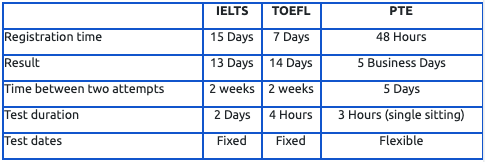Part 2 of the PTE Academic test is Reading. This part tests your ability to understand written English in an academic environment.
Multiple-choice, choose single answer
In this section, you read a text (up to 300 words). You are then given a multiple-choice question with three to five answer options. You choose the one correct answer option. You do two to three of these items, depending on the combination of items in your test.
TIPS:
– Take a quick look at the questions before you start reading the given passage. This will help you locate only the information you want.
– Read carefully and try to understand the main idea behind the passage. You should be able to describe it in your own words.
– Once you recognize the key idea of the text, look for the supporting ideas and details.
– Read the questions and options again, if needed. If you are able to find the correct answer, select it. Else, look for the ones that are absolutely incorrect. This will narrow your search process.
– Since the questions left unanswered are marked as incorrect, do not leave any of them unanswered. Try to choose the right option or make a guess.
– For effective time management, do not spend more than 1.5 minutes on one question
Multiple-choice, choose multiple answers
In this section, you read a text (up to 300 words). You are then given a multiple-choice question with five to seven answer options. You choose all the correct answer options. You do two to three of these items, depending on the combination of items in your test.
TIPS:
– Though it looks easy, multiple choice questions are quite tricky and challenging. So, read every given information carefully.
– Go through the questions and options given before you start reading the text
– Pay attention to adjectives, nouns and repeated words as it will help you find the correct responses quickly
– If you are not able to find out correct responses, start eliminating the ones which are least likely to be correct
– Spend no longer than 2 minutes on each multiple answer type question
Re-order paragraphs
In this section, you are given a text (up to 150 words) divided into paragraphs. The paragraphs are in the wrong order. You have to drag and drop the paragraphs into the correct order. You do two to three of these items, depending on the combination of items in your test.
TIPS:
– Look for the topic sentence that can stand alone. Every paragraph written in a logical order begins with a topic sentence. Unlike other sentences that follow to support ideas, links, facts and other information later in the paragraph, the topic sentence does not begin with any linker and can give you the much-needed opening.
– Search for the Nouns, Pronouns, Adjectives and time-related phrases. Pronouns such as he, she, they, these, those etc. will help you establish the right order quickly. Sentences beginning with Pronouns will never come first in the order.
– Pay attention to the clue-words
– Aim to spend no more than 3-4 minutes on any re-order the paragraph question
Reading: Fill in the blanks
In this section, you read a text (up to 80 words) which has blanks in it. You drag words from a box and drop each word onto the correct blank to complete the text. You do four to five of these items, depending on the combination of items in your test.
TIPS:
– Skim the text to grab the main idea of the passage
– Make use of ‘Collocation’ i.e. look for the words that often go together to form a phrase.
– Search for the missing part of speech to choose the right word for the gap. Always understand the context of the sentence before choosing the word. For instance, hearing and listening infer different meanings.
– Spend approximately 2 minutes on each question.
Reading and Writing: Fill in the blanks
In this section, you read a text (up to 300 words) which has blanks in it. You click on each blank and a drop down list appears. You choose the correct word from each list to complete the text. You do five to six of these items, depending on the combination of items in your test.
TIPS:
– Skim the text to grab the main idea of the passage
– Make use of ‘Collocation’ i.e. look for the words that often go together to form a phrase
– Search for the missing part of speech to choose the right word for the gap. Always understand the context of the sentence before choosing the word. For instance, hearing and listening infer different meanings.
– Spend approximately 2 minutes on each question.

